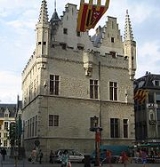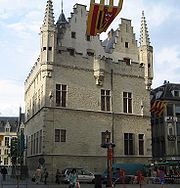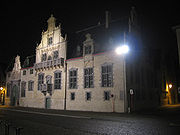
Great Council of Mechelen
Encyclopedia


Mechelen
Mechelen Footnote: Mechelen became known in English as 'Mechlin' from which the adjective 'Mechlinian' is derived...
(Dutch: De Grote Raad der Nederlanden te Mechelen; French: le grand conseil des Pays-Bas à Malines; German: der Grosse Rat der Niederlände zu Mecheln) was the highest court in the Burgundian Netherlands
Burgundian Netherlands
In the history of the Low Countries, the Burgundian Netherlands refers to a number of Imperial and French fiefs ruled in personal union by the House of Valois-Burgundy and their Habsburg heirs in the period from 1384 to 1482...
. It was responsible for the Dutch-, French- and German-speaking areas. In Luxembourgish
Luxembourgish language
Luxembourgish is a High German language spoken mainly in Luxembourg. About 320,000 people worldwide speak Luxembourgish.-Language family:...
the phrase "mir ginn op Mechelen" (we'll go to Mechelen) still means playing one's last trump card. The Grote Raad first sat in the Schepenhuis in Mechelen then, from 1616, in the (old) palace of Margaretha of Austria
Hof van Savoye
The Hof van Savoye or Palace of Margaret of Austria is an early 16th century building in Mechelen, Belgium. It was one of the first Renaissance buildings in northern Europe....
on Keizerstraat.
Origins and history
The medieval rulers were assisted by advisers. Together with the ruler they formed the Council of StateCouncil of State
The Council of State is a unique governmental body in a country or subdivision thereoff, though its nature may range from the formal name for the cabinet to a non-executive advisory body surrounding a head of state. It is sometimes regarded as the equivalent of a privy council.-Modern:*Belgian...
, also called the consilium or curia. Gradually the council became more specialised, with separate financial, judicial and political council emerging.
In the Burgundian Netherlands
Burgundian Netherlands
In the history of the Low Countries, the Burgundian Netherlands refers to a number of Imperial and French fiefs ruled in personal union by the House of Valois-Burgundy and their Habsburg heirs in the period from 1384 to 1482...
, the councils initially travelled with the Duke. In 1473 Duke Charles the Bold decided to establish the council in a specific location, in Mechelen
Mechelen
Mechelen Footnote: Mechelen became known in English as 'Mechlin' from which the adjective 'Mechlinian' is derived...
. The council took on the name of the Parliament of Mechelen. After Charles' death in 1477, this parliament was abolished again by Charles' daughter Mary of Burgundy on the occasion of the issuing of the Great Privilege
Great Privilege
The Great Privilege was an instrument signed by Mary of Burgundy on February 11, 1477 which reconfirmed a number of privileges to the States-General of the Netherlands...
. This was the result of the constant struggle between the centralisation of the rulers and the particularism of the states. The French king was also against a parliament in Mechelen, as it would become a rival of the Parliament of Paris. Nonetheless, under Philip the Fair
Philip I of Castile
Philip I , known as Philip the Handsome or the Fair, was the first Habsburg King of Castile...
, the Great Council was again established in Mechelen in 1504, this time permanently, but without the addition of parliament to its name.
In the 16th century the territorial powers of the Great council grew. Through the establishment of authority by Charles V, Holy Roman Emperor
Charles V, Holy Roman Emperor
Charles V was ruler of the Holy Roman Empire from 1519 and, as Charles I, of the Spanish Empire from 1516 until his voluntary retirement and abdication in favor of his younger brother Ferdinand I and his son Philip II in 1556.As...
over Tournai
Tournai
Tournai is a Walloon city and municipality of Belgium located 85 kilometres southwest of Brussels, on the river Scheldt, in the province of Hainaut....
, Utrecht
Utrecht (province)
Utrecht is the smallest province of the Netherlands in terms of area, and is located in the centre of the country. It is bordered by the Eemmeer in the north, Gelderland in the east, the river Rhine in the south, South Holland in the west, and North Holland in the northwest...
, Friesland
Friesland
Friesland is a province in the north of the Netherlands and part of the ancient region of Frisia.Until the end of 1996, the province bore Friesland as its official name. In 1997 this Dutch name lost its official status to the Frisian Fryslân...
, Overijssel
Overijssel
Overijssel is a province of the Netherlands in the central eastern part of the country. The region has a NUTS classification of NL21. The province's name means "Lands across river IJssel". The capital city of Overijssel is Zwolle and the largest city is Enschede...
and Guelders
Guelders
Guelders or Gueldres is the name of a historical county, later duchy of the Holy Roman Empire, located in the Low Countries.-Geography:...
, the council's territory now included all of the Seventeen Provinces
Seventeen Provinces
The Seventeen Provinces were a personal union of states in the Low Countries in the 15th century and 16th century, roughly covering the current Netherlands, Belgium, Luxembourg, a good part of the North of France , and a small part of Western Germany.The Seventeen Provinces were originally held by...
.
In 1526 the construction of a new Seat for the Great Council started by the architect and Master Mason Rombout II Keldermans
Rombout II Keldermans
Rombout II Keldermans was an important architect from the Gothic period, born from a family of architects and sculptors ....
. This Brabantine Gothic
Brabantine Gothic
Brabantine Gothic, occasionally called Brabantian Gothic, is a significant variant of Gothic architecture that is typical for the Low Countries...
project was abandoned in 1547 —with little more than the ground floor built.
Rombout II Keldermans
Rombout II Keldermans was an important architect from the Gothic period, born from a family of architects and sculptors ....
's Brabantine Gothic
Brabantine Gothic
Brabantine Gothic, occasionally called Brabantian Gothic, is a significant variant of Gothic architecture that is typical for the Low Countries...
design, with original drawings but as modified by Keldermans during the early phase, for the 'new' north wing of the Mechelen City Hall. The council was losing power and influence. After the Eighty Years' war, the Dutch Republic
Dutch Republic
The Dutch Republic — officially known as the Republic of the Seven United Netherlands , the Republic of the United Netherlands, or the Republic of the Seven United Provinces — was a republic in Europe existing from 1581 to 1795, preceding the Batavian Republic and ultimately...
became independent. In the Northern Netherlands, the judicial power was taken over by the provincial council and the Supreme court of Holland, Zeeland and West-Friesland (1582). The Great Council of Mechelen remained active in the remaining Southern Netherlands
Southern Netherlands
Southern Netherlands were a part of the Low Countries controlled by Spain , Austria and annexed by France...
, of which France annexed the southern province of Artois
Artois
Artois is a former province of northern France. Its territory has an area of around 4000 km² and a population of about one million. Its principal cities are Arras , Saint-Omer, Lens and Béthune.-Location:...
and parts of Flanders
County of Flanders
The County of Flanders was one of the territories constituting the Low Countries. The county existed from 862 to 1795. It was one of the original secular fiefs of France and for centuries was one of the most affluent regions in Europe....
, Hainaut
County of Hainaut
The County of Hainaut was a historical region in the Low Countries with its capital at Mons . In English sources it is often given the archaic spelling Hainault....
and Luxembourg. A number of provincial councils declared themselves independent from the Great Council: in the beginning of the 16th century the councils of Brabant
Duchy of Brabant
The Duchy of Brabant was a historical region in the Low Countries. Its territory consisted essentially of the three modern-day Belgian provinces of Flemish Brabant, Walloon Brabant and Antwerp, the Brussels-Capital Region and most of the present-day Dutch province of North Brabant.The Flag of...
and Hainaut
County of Hainaut
The County of Hainaut was a historical region in the Low Countries with its capital at Mons . In English sources it is often given the archaic spelling Hainault....
did this, and at the end (1782) the judicial councils of Luxembourg and Tournai as well. This left the Great Council only Flanders
County of Flanders
The County of Flanders was one of the territories constituting the Low Countries. The county existed from 862 to 1795. It was one of the original secular fiefs of France and for centuries was one of the most affluent regions in Europe....
, Mechelen
Mechelen
Mechelen Footnote: Mechelen became known in English as 'Mechlin' from which the adjective 'Mechlinian' is derived...
, Namur
Namur (city)
Namur is a city and municipality in Wallonia, in southern Belgium. It is both the capital of the province of Namur and of Wallonia....
and Upper Guelders
Upper Guelders
Upper Guelders or Spanish Guelders was one of the four quarters in the Imperial Duchy of Guelders. In the Dutch Revolt, it was the only quarter that did not secede from the Habsburg Monarchy to become part of the Seven United Netherlands, but remained under Spanish rule during the Eighty Years'...
.
The Great Council was abolished during the French Revolution
French Revolution
The French Revolution , sometimes distinguished as the 'Great French Revolution' , was a period of radical social and political upheaval in France and Europe. The absolute monarchy that had ruled France for centuries collapsed in three years...
. During the first French invasion in 1792, the Council moved to Roermond
Roermond
Roermond is a city, a municipality, and a diocese in the southeastern part of the Netherlands.The city of Roermond is a historically important town, on the lower Roer at the east bank of the Meuse river. It received city rights in 1231...
, where it watched over the last unoccupied lands, the twelve remaining municipalities of Austrian Guelders. During the second French invasion in 1794, part of the council members moved to Regensburg
Regensburg
Regensburg is a city in Bavaria, Germany, located at the confluence of the Danube and Regen rivers, at the northernmost bend in the Danube. To the east lies the Bavarian Forest. Regensburg is the capital of the Bavarian administrative region Upper Palatinate...
and Augsburg
Augsburg
Augsburg is a city in the south-west of Bavaria, Germany. It is a university town and home of the Regierungsbezirk Schwaben and the Bezirk Schwaben. Augsburg is an urban district and home to the institutions of the Landkreis Augsburg. It is, as of 2008, the third-largest city in Bavaria with a...
, in imperial territory; another part chose for the new regime and became part of the new judicial organisation.
Composition
The composition of the Great Council was notacibly stable throughout the centuries. It had one chairman or president, 15 to 16 councillors, one procureur-general, one replacement procureur-general, one fiscal advocate, 10 paid secretaries, two or three clerks, advocates and lastly Huissier de justiceHuissier de justice
Huissier de justice is the French term, hence used in France, Luxembourg, Quebec, Suisse romande, and the French Community of Belgium, named gerechtsdeurwaarder in Dutch for the Flemish Community and the Netherlands, for a specific legal officer that also occurs in Greece, Italy and the three other...
. Of the councillors, who wore red vestments, traditionally four were clerical, later lessened to two. All councillors were appointed by the ruler from a list of candidates of the Council itself. They had to be licentiate
Licentiate
Licentiate is the title of a person who holds an academic degree called a licence. The term may derive from the Latin licentia docendi, meaning permission to teach. The term may also derive from the Latin licentia ad practicandum, which signified someone who held a certificate of competence to...
or doctor
Doctor (title)
Doctor, as a title, originates from the Latin word of the same spelling and meaning. The word is originally an agentive noun of the Latin verb docēre . It has been used as an honored academic title for over a millennium in Europe, where it dates back to the rise of the university. This use spread...
in law at one of the universities in the ruler's lands.
The following people were councilmembers:
- Jan I CarondeletJan I CarondeletJan I Carondelet was a Burgundian jurist and politician. He was the son of Jean Carondelet and Jeanne de Basan.-Life:...
- Jan II CarondeletJean CarondeletJean II Carondelet , was a Burgundian cleric, politician, jurist and one of the most important advisors to Charles V, Holy Roman Emperor. He was a patron of Erasmus and a brother of Ferry Carondelet.-Life:...
- Nicolaas EveraertsNicolaas EveraertsNicolaas Everaerts, also called Nicolaus Everardi was a Dutch jurist and the father of Johannes Secundus, an acclaimed poet. He is not to be confused with Nicolaus Everardi and his son Nicolaus Everardi , both professors in Ingolstadt.-Biography:Born in Grijpskerke, he studied in Leuven, where he...
- Jeroen Van BusleydenJeroen van BusleydenJeroen Van Busleyden was a patron of learning and humanist from the Southern Netherlands, the Belgian part of the Burgundian Netherlands, c.q. Leo Belgicus.-Life:...
- VigliusVigliusViglius , was the name taken by Wigle Aytta van Zwichem, a Dutch statesman and jurist, a Frisian by birth....
- Filips Wielant
Impressive buildings built by the councillors include:
- Hof van Busleyden
- Hof van Palermo
- Hof van Prant
Role
The competence of the Great Council strongly fluctuated from period to period and from province to province. In the small heerlijkheid Mechelen, it controlled practically all legislative and executiveExecutive (government)
Executive branch of Government is the part of government that has sole authority and responsibility for the daily administration of the state bureaucracy. The division of power into separate branches of government is central to the idea of the separation of powers.In many countries, the term...
power. It was also the court, for both initial charges and appeals for persons and institutions that fell under royal protection. Members of the court, knights of the Order of the Golden Fleece
Order of the Golden Fleece
The Order of the Golden Fleece is an order of chivalry founded in Bruges by Philip III, Duke of Burgundy in 1430, to celebrate his marriage to the Portuguese princess Infanta Isabella of Portugal, daughter of King John I of Portugal. It evolved as one of the most prestigious orders in Europe...
, and everyone who was privileged through title or function could only be judged before the Great Council. For the rest the Council functioned as a court of appeal and a court of cassation
Supreme court
A supreme court is the highest court within the hierarchy of many legal jurisdictions. Other descriptions for such courts include court of last resort, instance court, judgment court, high court, or apex court...
over all sentences made by provincial justice councils and other, lower, courts in the Seventeen Provinces (or what remained of it later on). The Great Council also treated issues of privilege
Privilege
A privilege is a special entitlement to immunity granted by the state or another authority to a restricted group, either by birth or on a conditional basis. It can be revoked in certain circumstances. In modern democratic states, a privilege is conditional and granted only after birth...
s, mandates, letters of commendation, letters of marque, donations of functions and goods, gifts and other taxes, confiscation of property, jurisdiction conflicts between separate government institutions, and also border conflicts.
Appeals against judicial rulings were also handled, but generally only against serious cases. On the other hand, family rights and inheritance
Inheritance
Inheritance is the practice of passing on property, titles, debts, rights and obligations upon the death of an individual. It has long played an important role in human societies...
usually fell under the jurisdiction of the church courts.
Archives of the Great Council of Mechelen can be found in the National and Provincial State Archives in Brussels
Brussels
Brussels , officially the Brussels Region or Brussels-Capital Region , is the capital of Belgium and the de facto capital of the European Union...
and the Archives Départementales du Nort in Lille
Lille
Lille is a city in northern France . It is the principal city of the Lille Métropole, the fourth-largest metropolitan area in the country behind those of Paris, Lyon and Marseille. Lille is situated on the Deûle River, near France's border with Belgium...
. Because it held jurisdiction over large areas and widely ranging subjects during its three centuries of existence, the Great Council takes an important place in the Legal history
Legal history
Legal history or the history of law is the study of how law has evolved and why it changed. Legal history is closely connected to the development of civilizations and is set in the wider context of social history...
of the Netherlands and Belgium.

